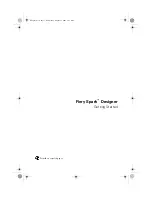
Key and Mouse Bindings
Key and mouse bindings are quick ways to execute operations in SlickEdit
®
Core. Key bindings are the
most efficient. Time is wasted each time you lift your hand from the keyboard to grab the mouse, and
more time is wasted when you move your hand back to the keyboard in preparation for more typing.
Therefore, if you learn the key bindings associated with operations that you use most frequently, you will
save time coding. If an operation you use frequently isn’t already bound by default, create your own easy-
to-remember binding.
What is a Binding?
A key or mouse binding is a key sequence or mouse event associated with a command. Key terms are
defined as follows:
•
Mouse event
- The clicking of any button or motion of the mouse wheel.
•
Key sequence
- A series of one or more keys or key combinations. For example,
Ctrl
+
X
,
R
.
•
Key combination
- Two or more keys pressed simultaneously. For example,
Ctrl
+
O
.
•
Key
- Any single key on the keyboard.
An example of a key binding with one key combination is
Ctrl
+
O
(in CUA emulation, associated with the
gui_open
command and
File
→
Open File
). The plus (+) sign between the keys indicates that these keys
must be pressed simultaneously: press the
Ctrl
and
O
keys at the same time. Note that the last key is
case-insensitive. You do not need to press
Shift
.
An example of a key binding with a key sequence is
Ctrl
+
X
,
R
(in Vim emulation, this binding is associated
with the
redo
command and
Edit
→
Redo
). The comma (,) indicates that each key must be pressed con-
secutively: press
Ctrl
and
X
at the same time, release, then press the
R
key.
To view or change bindings, create new bindings, and export/import custom bindings, see
Managing
Bindings
.
The available key bindings change depending on the selected emulation. While SlickEdit
®
Core provides
emulations for 13 editors, CUA is the default emulation, so key bindings listed throughout the documenta-
tion will be for the CUA emulation. To change the emulation mode, click
Window
→
Preferences
, expand
SlickEdit
and click
General
in the tree, then double-click the
Emulation
setting. For more information,
see
Emulations
.
Note
• For documentation purposes, both mouse events and keys that are bound to commands are of-
ten referred to collectively as
key bindings
.
• The main menu displays the key bindings for commands associated with each menu entry. See
Menus
Accessing Menus and
Creating and Editing Menus
for more information.
What is a Binding?
44
Summary of Contents for Corev3.3 for Eclipse
Page 1: ...Think Slick Corev3 3 for Eclipse...
Page 2: ......
Page 3: ...SlickEdit Core v3 3 for Eclipse...
Page 5: ......
Page 6: ......
Page 14: ...xii...
Page 20: ...xviii...
Page 22: ...xx...
Page 23: ...Chapter 1 Introduction 1...
Page 41: ...Chapter 3 User Interface 19...
Page 61: ...Chapter 4 User Preferences 39...
Page 80: ...BODY BODY HTML HTMLEOF Restoring Settings on Startup 58...
Page 82: ...60...
Page 83: ...Chapter 5 Context Tagging 61...
Page 97: ...Chapter 6 Editing Features 75...
Page 124: ...Code Templates 102...
Page 238: ...Figure 6 49 Test Parsing Configuration Example 1 C Refactoring 216...
Page 241: ...Figure 6 51 Test Parsing Configuration Example 3 Reviewing Refactoring Changes 219...
Page 250: ...228...
Page 251: ...Chapter 7 Language Specific Editing 229...
Page 328: ...306...
Page 329: ...Chapter 8 Tools and Utilities 307...
Page 350: ...328...
Page 351: ...Chapter 9 Macros and Macro Programming 329...
Page 360: ...338...
Page 361: ...Chapter 10 SlickEdit Core Dialogs 339...
Page 375: ...Find and Replace View 353...
Page 491: ...Chapter 11 Appendix 469...
Page 567: ......
Page 568: ......
















































